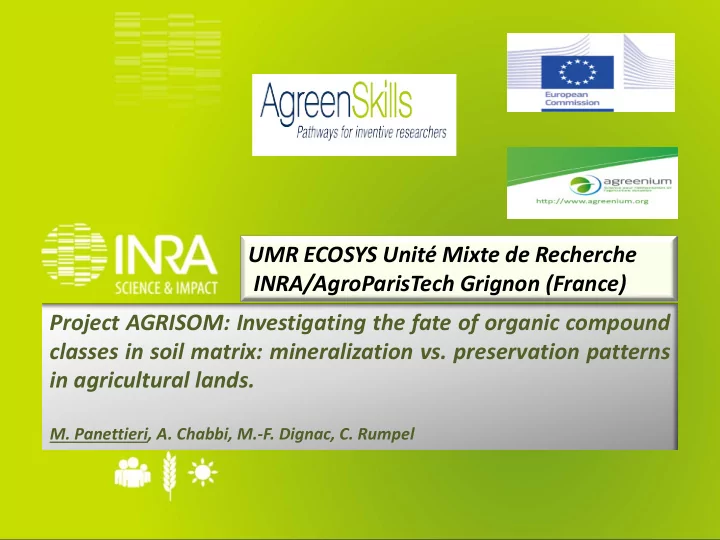

UMR ECOSYS Unité Mixte de Recherche INRA/AgroParisTech Grignon (France) Project AGRISOM: Investigating the fate of organic compound classes in soil matrix: mineralization vs. preservation patterns in agricultural lands. M. Panettieri, A. Chabbi, M.-F. Dignac, C. Rumpel
Sevilla Cosenza PhD in Natural resources and environment at the Institute MSc in Pharmaceutical chemistry and technology at of natural resources and agrobiology (IRNAS-CSIC) University of Calabria (UNICAL) Grignon Project (Paris) AGRISOM
Summary of PhD research Effect of tillage on soil quality Tools: • Carbon pools • Enzymatic activities • Crops productivity • NMR Mouldboard Loss of soil quality Chisel led to erosion in a hilly farm under mouldboard Direct Drilling Panettieri et al. (2013), Moldboard plowing effects on soil aggregation and soil organic matter quality assessed by 13 C CPMAS NMR and biochemical analyses. Agriculture, Ecosystem and Environment
Project AGRISOM A sustainable land management improves crop yields, soil quality, and carbon storage. Soil can act both as a carbon sink or a GHG source, depending on edaphological and climatic conditions, which influence the cycles of Soil Organic Matter (SOM). The mechanisms that underlie the accrual of organic C from plant litter to SOM remain widely unknown ( Ludwig et al., 2015) Cropland Ley (temporary) grasslands have SOM SOM higher potential for SOM sequestration than permanent cropland (Lemaire et al., 2015) Grassland Changes in land use affect carbon dynamics within the soil matrix. An evaluation of those effects under ley grassland is needed.
Project AGRISOM Objective: Evaluate the effects of land use on the storage of SOM at a molecular level SOM storage follow different patterns in the soil matrix due to: ? Chemical composition Chemical protection Seasonal of the litter Biochemical (organo-mineral Phisical and spatial constraints interacions) protection variability (aggregation) Biodiversity
Strategy and tools SOERE-ACBB observatory in Lusignan on permanent and temporary grassland. C4 plants Maize 3y 2005-2025 long term experiment Grassland 6y Maize is a C4 plant rich in 13 C, stable isotopes analyses trace the rate of incorporation of new SOM Use high resolution techniques of spectrometry (MS and NMR) Decompose the mosaic of soil matrix (soil aggregates and particulate C org ) Focus on compound specific analyses (biomarkers: lignins, sugars, cutins, suberins) Upscaling from fractions to complete soil, from compound specific to total SOM
Results Lignin turnover rates in bulk soil Monomers turnover rates in bulk soil Soil Organic Carbon 70 Cropland Ley grassland 70 % of Maize derived compounds % of Maize derived compounds 18 9 Years Maize Grassland Bare Soil 9 Years Maize 60 60 16 c Ley Grassland, 3 Years Maize Ley Grassland, 3 Years Maize b 14 50 50 bc C org g kg -1 soil 12 b 40 40 ab 10 a 30 30 8 a a 6 20 20 4 10 10 2 0 0 0 The aggregate fractionation unveiled Lignin turnover is compound specific different SOM dynamics
For your attention! To all the researchers and technicians involved in this project INRA, AgroParisTech, Unité Mixte de Recherche 1402 ECOSYS, Thiverval-Grignon, France • SOERE ACBB - Systeme d‘Observation et d‘Experimentation sur Le Long Terme pour la Recherche en • Environnement - Agro-ecosysteme, Cycle Bio-geochimique et Biodiversite
Recommend
More recommend